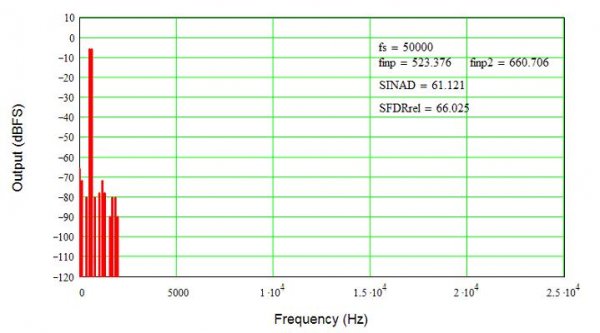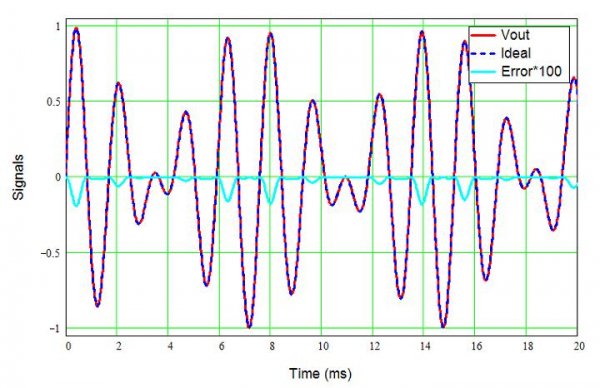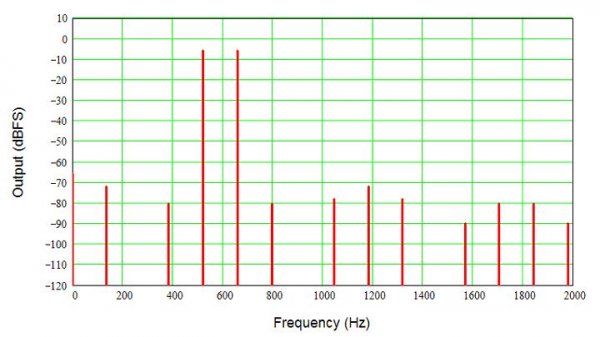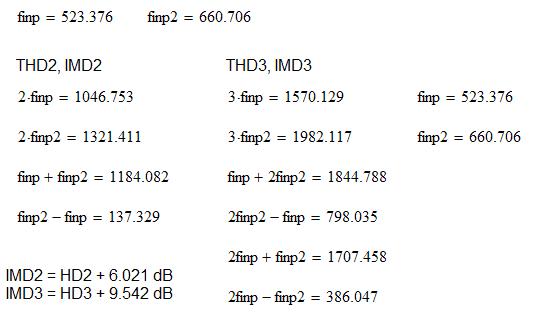A previous post discussed harmonic distortion (HD), but to most people intermodulation distortion (IMD) is far more objectionable. Why? Because IMD generates tones that are not harmonically related to the input signals, and these tones “stick out” more than tones that are harmonics of the input tones. They sound “off” to our ears.
As an example, I created two tones at around 523 Hz (C above middle C on a piano) and 661 Hz (the E above, the root and third of a major chord). I added 0.1 % second- and third-order distortion terms (x^2 and x^3) and plotted the spectrum.

You can see the two signal tones at -6 dB, and a group of distortion spurs (tones) around the signal. I used -6 dB (0.5 full-scale) because two signals added will peak at 0 dB when they are each at one-half full-scale. You can see that in the next picture, which shows a few cycles of the signal. The funny-looking waveform is a result of the two signals mixing together, adding and subtracting from each other at different times. Even though each signal alone would only reach 0.5, together they reach 1.0 when they are in phase so both signals add. The error signal is multiple by 100 to make it easier to see; otherwise, the 0.1 % error would be essentially invisible by eye.

Below is a zoom showing the bunched signals, and a table of all the frequencies present. Not only do we have harmonics of each signal, at 2x and 3x the fundamental tones, but also intermodulation sum and difference terms. That means that we get C and E, and their second and third octaves, but also a tone a little over high D, a little below a low C# from the second-order IMD. The third-order IMD gives back the fundamental tones (but in general out of phase, causing amplitude modulation), and tones around a couple of (lower and higher) G’s (not too bad), Bb (oops), and a strange tone about half-way between Ab and A (what?) As a matter of fact, none of the IMD tones lie exactly on a piano note. These added tones add dissonance not in the original chord structure, and our ears are pretty good at picking out this dissonance. Yuck.


So, IMD creates non-harmonic tones, tones that do not lie in the chord, and that sounds bad. One other note: IMD tones are actually higher in magnitude than HD tones. Theoretically, IMD-2 tones are 6.021 dB higher than HD-2 tones, and IMD-3 tones are 9.542 dB above the corresponding HD-3 tones. Adding insult to injury… This is another reason IMD is more important than HD in the real world.
The derivation of all this is straight-forward but tedious. Take a couple of signals represented by Vin=sin(2*pi*f1*t)+sin(2*pi*f2*t), then build a function using
Vout = Vin + HD2*Vin^2 + HD3*Vin^3
After expanding out the terms and plugging in various trig identities you will find the terms in the table above, and the relation between HD and IMD amplitudes.
Hope this is useful - Don
As an example, I created two tones at around 523 Hz (C above middle C on a piano) and 661 Hz (the E above, the root and third of a major chord). I added 0.1 % second- and third-order distortion terms (x^2 and x^3) and plotted the spectrum.

You can see the two signal tones at -6 dB, and a group of distortion spurs (tones) around the signal. I used -6 dB (0.5 full-scale) because two signals added will peak at 0 dB when they are each at one-half full-scale. You can see that in the next picture, which shows a few cycles of the signal. The funny-looking waveform is a result of the two signals mixing together, adding and subtracting from each other at different times. Even though each signal alone would only reach 0.5, together they reach 1.0 when they are in phase so both signals add. The error signal is multiple by 100 to make it easier to see; otherwise, the 0.1 % error would be essentially invisible by eye.

Below is a zoom showing the bunched signals, and a table of all the frequencies present. Not only do we have harmonics of each signal, at 2x and 3x the fundamental tones, but also intermodulation sum and difference terms. That means that we get C and E, and their second and third octaves, but also a tone a little over high D, a little below a low C# from the second-order IMD. The third-order IMD gives back the fundamental tones (but in general out of phase, causing amplitude modulation), and tones around a couple of (lower and higher) G’s (not too bad), Bb (oops), and a strange tone about half-way between Ab and A (what?) As a matter of fact, none of the IMD tones lie exactly on a piano note. These added tones add dissonance not in the original chord structure, and our ears are pretty good at picking out this dissonance. Yuck.


So, IMD creates non-harmonic tones, tones that do not lie in the chord, and that sounds bad. One other note: IMD tones are actually higher in magnitude than HD tones. Theoretically, IMD-2 tones are 6.021 dB higher than HD-2 tones, and IMD-3 tones are 9.542 dB above the corresponding HD-3 tones. Adding insult to injury… This is another reason IMD is more important than HD in the real world.
The derivation of all this is straight-forward but tedious. Take a couple of signals represented by Vin=sin(2*pi*f1*t)+sin(2*pi*f2*t), then build a function using
Vout = Vin + HD2*Vin^2 + HD3*Vin^3
After expanding out the terms and plugging in various trig identities you will find the terms in the table above, and the relation between HD and IMD amplitudes.
Hope this is useful - Don
Last edited:

